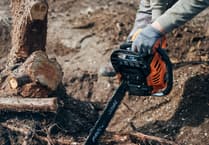THOUSANDS of fish had to be gently zapped before they were temporarily rehomed in the Monmouthshire and Brecon Canal last week.
The operation carried out by fisheries experts was part of a major project by Glandwr Cymru to repair the lining of the canal near Brecon.
The stretch of the canal between Brynich Turn (bridge 162) and Ty-Newydd bridge (160) was partly drained and then a two-man team of fisheries experts braved the cold waters to remove species such as roach, perch, eels, chub and bream.
They used a method called electrofishing to zap the fish so they would float to the surface and be caught in a fishing net before being transferred to a section of the canal that was still full of water.
The operation to drain the canal was carried out last Thursday (November 8) and the catching and transfer of the fish took place on Friday.
Once this part of the operation is complete the next stage will be to drain millions of litres of water from the canal so repairs can be carried out to the waterway wall.
The project is part of a £545,000 programme of repairs to canals across Wales over the winter months. The work takes in seven locations along the Monmouthshire & Brecon Canal, which has been voted among the most popular attractions in the Brecon Beacons National Park, to help keep the canal watertight, replace and repair lock gates, and improve towpaths.
Meanwhile the Llangollen Canal in north Wales, which is home to the Pontcysyllte Aqueduct and its Unesco World Heritage site, will see railing improvements on the aqueduct and upgrades to the 175-metre long Whitehouses Tunnel.
Kevin Phillips, Glandwr Cymru waterway supervisor, said: “The Monmouthshire & Brecon Canal is one of the most beautiful canals anywhere in Britain, and it’s vital for the local economy. People live on, work on, and visit the canal, but at 200 years old it needs plenty of care and these works are a great example of the type of things we need to do to keep it in good condition.
“A method called electrofishing is being used to collect the fish so that we can transfer them to another section of the canal.
“It’s a bit unusual to see the expert team wading through the water with theses contraptions that look a bit like metal detectors. These essentially tickle the fish so that they temporarily stop swimming and can be gently netted and rehomed. While we’ll be working on some key sections, the remainder of the canal is still open so I’d encourage everyone to come and discover all it has to offer.”
Glandwr Cymru is The Canal & River Trust in Wales. For more information about projects run by the charitable trust and how to make a donation visit the Glandwr Cymru website.




